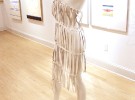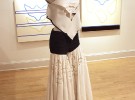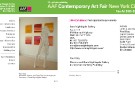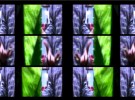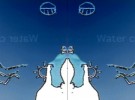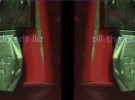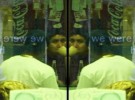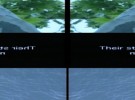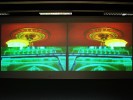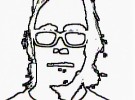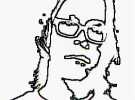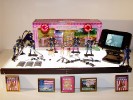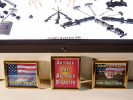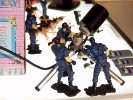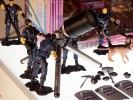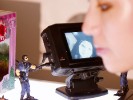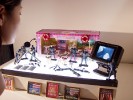Presented in the group art exhibit “Beautiful, Male, Objects” at Sarah Nightingale Gallery, South Hampton, NY, 2004.
Â
Wearable Objects-Project Description
This work came out of the some of the same set of interests that fueled the Fictive Runway project. I had a continued fascination with cheap found or store-bought items which could be incorporated into contemporary fashion, both to acknowledge their beauty, and also to revalue the lingering traces of craft practices still to be found in mass produced objects.
Watchbandwear: The first of the three works is made from a sheet of white leather, found in the trash on the street. It is from a company that was producing watchbands for children’s watches, and the piece is the left over, after the items were cut from it. The dress works almost like an apron, with a simple ribbon at the back for closure. As a result of the crisscross it also reads a little like lingerie.
Tablewear: The second work is made from two table cloths and a napkin, along with blue jean fabric. This piece has amazing movement properties when worn, with the legs of the pants functioning almost like a bolero dress for flamenco dancing. It also has a “country” feel, but with an exposed back and open slots near the breast and midriff, also reads as sexy club-wear.
Jumpropewear: The third work is made from children’s plastic jump ropes, white trevira voile, and elastic waistband material, like that used for simple cotton underwear. This piece is entirely un sewn, and was made using knitting needles to pierce the elastic band and with the trevira voile knotted to it.
A one hour, two channel video work, commissioned by the Hudson Valley Center for Contemporary Art.
Video Stills:
Photo Documentation:
Video Excerpt:
(Note: Best watched in High Quality – Click video once to play, then after video begins click the “HQ” icon on the lower right. Video will restart in High Quality.)
[tubepress mode=’playlist’, playlistValue=’41558420184570AA’]
Download PDF of the New York Times Review:Â
VIDEO REVIEW; “The History of Peekskill, as Collage” By BENJAMIN GENOCCHIO, Jan 23, 2005
Project Description:
“When We Came” tells the story of Peekskill from the dawn of human beings, and uses the Hudson River as a point of focus. The mirrored video makes reference to water as reflection and to the flip side of history that we are seldom aware of, an angle from which our own language and perceptions seem foreign and “other”.
It begins with the text of an African creation myth from Ghana. Africa – the origin point for human kind. A great number of African Americans originally came from Ghana and most passed through Almina Castle in Cape Coast, a Dutch fort in the slave trade. Peekskill has been a key center in African American development and resistance in the New World since before the Revolutionary War.
The African myth explains the origin of Water Sun and Moon, and why Water still lives with us on the earth. Peekskill is about water, about the Hudson River. It formed from a retreating glacier at the end of the last ice age. It is a New World that has been continuously being rediscovered for the last 12,500 years. The early Native American Paleo People, the Shield Archaic people, the Mahicans, the Iroquois, the Wappinger, and the Kitchawak an Algonquian people, who lived in the town of Peekskill or Sackhoes, as they liked to call it, before the European peoples ever even arrived.
The story of Peekskill is about visitors coming up the Hudson from New York. This includes Jan Peek, for whom the town is named, (“Peek’s Creek” in Dutch) who lived in the settlement of New Amsterdam which was later renamed New York. Jan came up the Hudson to trade with the Kitchawak at Sackhoes. Other New Yorkers also traded goods by boat and later by car and train. They brought ideas too. Young Russian Jewish women fleeing the nightmare of the Triangle Shirt Waist Factory fire and trying to start a better life free of labor exploitation. African Americans coming up from the AME Zion Church, and from Harlem, working towards equality. Soho artists driven out by soaring real estate prices looking for a place to create and express their art.
They came from other places besides New York too. The Italians, the Irish, the Chinese as they built the railroads. The British first to burn the place, and later to establish families. African Americans fleeing slavery in the South via the Underground Railroad. Equadorans, Guatemalans, and others from even further South, looking for a better life.
There is a long and tumultuous history of arrivals in this place, filled with great strife and great beauty. We are only the current caretakers and ours is a momentary passing in the long history of the river valley. The “Muh-he-kun-ne-tuk” – as the Mahicans would call it when they first came 6000 years ago. “The place where the waters are never still”. In this work we too arrive. The strangers, the outsiders, the new comers. We try to document, to make a record, so others who come after can know what we experienced, how we felt. So they might see what we saw – when we came.
Conceived by Paul Clay, Video Mix: Paul Clay,  Audio Mix: Arrow Chrome.
Fifteen minute long, black and white line drawing on video, first presented as part of the group exhibit entitled “Selfish”, at Gallery 128, New York City. The piece created for this group exhibit about self portraits.
Â
Photo Documentation and video stills:
Â
Video Sample:
[tubepress mode=’playlist’, playlistValue=’196C105AC18D1CB3′]
Project Description:
The work was recorded live with the filters which were “drawing” the video and being manipulated live in real time. it plays with the idea of what drawing constitutes in contemporary digital society and of course makes playful reference to Andy Warhol’s 1968 quote that “In the future, everyone will be world-famous for 15 minutes.”
What Makes Today’s Home So Secure, So Appealing? is a 11″h x 17″d x 24″w Mixed media sculpture involving a light box, children’s toys, a working infra red video camera and 4″ monitor.
Â
Project Description:
Coming to my art studio in the Lower East Side a day after 9/11, I had to pass two different police road blocks. At the second one an officer stopped me. Ten minutes later someone else on duty let me pass. I was grateful, but chilled by the experience. Who was in charge? What rules were they following? The security was for my safety, yet was directed against me. I had a sudden gut impression. What if a totalitarian state seized control of this nation from the inside? The rhetoric would still all be pro America, but there would be no free nation left.
Tomorrow seems to have already arrived. Americans detained without due process. Wholesale spying on citizenry. Microsoft’s’ highly touted “Trusted Computing Platform” and “Digital Rights Management” software which assumes every computer owner is a hostile agent. Corporations seizing national assets. World War II Nazi recruitment posters being reused with altered text by the new US Department of Homeland Security. It is a time of heightened terror, and propaganda.
The work’s title references another artwork made in the 1950s, at a previous time of fear and extreme consumerism – Richard Hamilton’s famous work from the Independent Group’s show ‘This is Tomorrow’. The current work is less a reference to pop art and more to some of Hamilton’s methods and concerns. He was part of a group of artists and intellectuals who met to discuss cultural change, the influence of technology, current media and design, as well as the sociology of London’s working class. He collaged together bits of advertising detritus to make powerful visceral work about the culture of the time. He has an acute awareness of, as Michael Bracewell put it, “the usefulness of transgressive or absurd imagery” and a comprehension of the contradictions between our desires and the way we try to fulfill them.
This work also uses bits of consumer culture. The toy figures demonstrate an insane conflation of war and rescue and could never have existed pre-9/11. As though we were “Godzilla, King of the Monsters” (released in the US in 1956, the same year as the Whitechapel exhibit), the puny if musclebound toys fixate on the viewer with their “cannon” tripod, shoot the viewer, and capture her/him on video. They use power and control to preserve the homeland, and the domestic sphere – with its sinage trumpeting happiness, but completely encased in plastic packaging, a shiny highly protected, surface. An actual separation from our homes and lives and loves could happen, and for some it has already. The full extent of terror may just be getting started, and the most frightening possible outcome is a time when there is no longer a strong, free and democratic nation to oppose it. It is the manipulation of our collective fears which makes this false “security” seem so appallingly appealing.
The Artist Drawing from the Model (HTML image tag for an unfinished work)
Presented in the group exhibit “Shared” – organized by Mark Power
A Graphite drawing on paper, of the invisible HTML image placement tag for a jpeg of the following drawing: “Rembrandt van Rijn, Dutch, 1606 – 1669, The Artist Drawing from the Model, c. 1639, Â etching, drypoint and burin, sheet: 23.4 x 18.2 cm (9 3/16 x 7 3/16 in.), Â Print Purchase Fund (Rosenwald Collection), 1968.4.1, from “the collection” directory of the National Gallery of Art, Washington D.C.’s web site.
Original URL: http://www.nga.gov/cgi-bin/pinfo?Object=50563+0+none
HTML Code Snippet:
<img align=”bottom”
src=”/thumb-l/a00054/a0005462.jpg”
width=”152″ height=”190″ border=”0″
alt=”image of The Artist Drawing from the Model”>
Project Description:
It is a kind of take on the Rembrandt van Rijn work and the process of art making, but it is also intended to explore some of the issues of what it means to be an artist today.
The work references the unfinished etching by Rembrandt and the invisible information tags or code which instruct web browser software how to draw web pages. The Webpage itself is unfinished until the image associated with the tag is added, completing the composition.
With his etching, Rembrandt was in the process of creating a kind of quintessential popular image of the “artist”, and the artist in the image could be Rembrandt himself, as the working figure bears some resemblance to his other self portraits. The artist is drawing the model while surrounded by the paraphernalia of the studio, and immediately behind him, a large unpainted canvas rests on its easel.
There are other references as well. In the right background is a sculpted bust covered over with a cloth. The model stands on a low platform while holding some fabric and a palm frond. Common enough props, but also visual suggestions that, even though the artist is drawing rather than sculpting, Rembrandt, the history painter, is working with the idea of Pygmalion.
It is Pygmalion’s story, in a round about way, that leads to the inspiration for the 2004 artwork. Pygmalion, legendary figure of Cyprus, is referenced in Ovid’s Metamorphoses,book 10, in which he is a sculptor who falls in love with a female statue he carved out of ivory. According to Ovid, after seeing the Propoetides prostituting themselves, Pygmalion is ‘not interested in women’, but his statue is so realistic that he falls in love with it. He offers the statue presents and eventually prays to Venus who takes pity on him and brings the statue to life.
The story of living statues has parallels with Daedalus, who was said to use quicksilver to make his statues speak, and Hephaestus, who created automata for his workshop, and even Pandora, and the Golem who were both said to be created from clay. Though this is myth, it is inspired by actual fact.
The eastern Mediterranean islands were known in ancient times for their astounding mechanical engineering creations, including what today might be referred to as animatrons or mechanical people. Pindar the Greek poet notes in describing Rhodes: “The animated figures stand adorning every public street and seem to breathe in stone, or move their marble feet.” The Antikythera mechanism, the first known mechanical computer, designed to calculate astronomical positions, was discovered in a wreck off the Greek island of Antikythera in 1901, and is dated to about 150–100 BC.
So in the story of Pygmalion the idea of conceptual or aesthetic creation, engineering and computing, and religious/magical substantiation is all tied together, and comes from the commonplace trope of sculptures so lifelike they are real.
In contemporary society individuation of tasks has continued in a branching process for a long time, with the engineer and the artist seemingly having parted ways. Yet recent technological innovations such as desktop publishing and laptop video production are allowing specializations to recombine, and allowing non specialists to take on tasks previously accessible only to experts.
Further, new technologies are regularly picked up by contemporary artists to create work with. Recent developments in computer code have even provoked engineers and programers to question whether what they are doing can be said to constitute an art form in itself. Â All kinds of media are being used and explored and exploited as art. Thus this snippet of computer code works for a variety of reasons to make an analogy with Rembrandt’s work about artists.
Rembrandt is known for his amazing ability to convey feeling through physical gesture. His work is about an artist drawing, and so I also try my hand at physical gesture in graphite. The text in the 2004 artwork has not been written, but has been delineated by sketching the outlines of the forms of letters and then filling them in. Van Rijn’s work has a meta level to it, with the story of drawing contained within the actual drawing. Likewise the drawing of computer code functions as a meta level for the jpeg image of drawing it refers to.
The copied code for the jpeg from National Gallery of Art site becomes a kind of conceit. The code is about location, position and relationship to surroundings, as well as the fact that there is no border or frame to be drawn around the image. All this loosely relates to the artists surroundings and the unframed canvas featured in Rembrandt’s background. The word “thumb” becomes a synecdoche referring to the artist’s drawing hand. Lastly, the female figure Galatea (“she who is milk-white”), appears in countless paintings of the Pygmalion myth shown from behind, just as she does in Rembrandt’s work. The code referring to image alignment (img align=”bottom”) thus functions as a joking reference to the glowing white ass that becomes the central image in these male dominated fantasies, and equates with the structuring of the viewer’s gaze to align on Galatea’s Bottom.
It has been said that for Rembrandt etching a plate was a process of exploration, not a straightforward transcription. In his work he is considering details for a kind of portrait of an artist. Yet it is not a portrait of what the artist looks like, but rather what his circumstances are, and what drives him.
The drawing of a bit of text with pencil on paper seems hardly a finished work, and the code itself without the final jpeg image inserted would constitute an unfinished web page. In The Artist Drawing from the Model (HTML image tag for an unfinished work,) the project of what it means to be an artist is being worked, and yet it remains unresolved.
